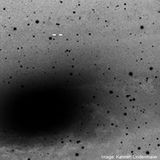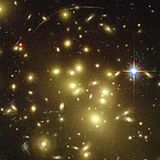
A variable star is a star which oscillates in brightness over time. The earliest known variable star is Mira, a red star in the constellation Cetus. While there is some indication that Mira was known as a variable star since ancient times, the earliest well-documented source dates to the 1500s.
We now know that Mira is a red giant star with a mass slightly larger than our Sun. It varies in brightness as it expands and contracts. Mira has nearly exhausted its hydrogen fuel, so it is chugging along like a car running out of fuel. As fusion slows in the core, the resulting drop in heat and pressure in the star allows gravity to compress the star further. This drives up the temperature and pressure in the star enough to allow fusion to continue for a bit, but the resulting heat and pressure causes the star to expand. The central temperature of the star drops, and the star again stops fusing hydrogen. Then gravity collapses the star again, and the cycle repeats itself.
There are about 6,000 known Mira-type variable stars. All of these are stars similar to our own, and in the last stages of their life. In a few billion years our Sun will become a Mira variable, so these stars provide a glimpse of our future.
Perhaps the most famous variable stars are Cepheid variables. These are named after the star Delta Cephei, first documented as a variable star in the late 1700s. Like Mira variables, Cepheid variables are also stars at the end of their lives. But Cepheid stars are much more massive than the Sun, typically 3 - 30 solar masses. Their variability is driven by the Eddington wave mechanism, which means their rate of variability is proportional to their absolute magnitude (brightness). This relation was first discovered by Henrietta Swan Leavitt in the early 1900s.
Since the absolute magnitude of Cepheids can be determined by their rate of variation, they are a powerful tool for determining the distance to galaxies as distant as 100 million light years. By comparing their calculated absolute magnitude with their observed apparent magnitude one can calculate their distance, as well as the distance of the galaxies in which they reside. Edwin Hubble relied on Leavitt's work with Cepheids when he compared the measured distances of galaxies with their redshifts, providing the first evidence of cosmic expansion.
Crucial to our understanding of variable stars is the determination of their light curves. Since variable stars are common, and their variations can span more than a year, this requires a great deal of long term careful observations.
In 1911, the American Association of Variable Star Observers (AAVSO) was established to coordinate, collect and analyze observational data on variable stars. The association currently has over 2000 members; many of them amateur astronomers. Collecting more than a million observations annually, the AAVSO has become a crucial resource for observational astronomy, and is often cited in refereed scientific journals. The data is of high quality, and made available to professional astronomers. AAVSO also has an active outreach program, and encourages anyone with an interest in observational astronomy to participate.
If you have a personal telescope, stars such as Mira and Chi Cygni are good variable stars to begin observing. They have variable periods of 333 and 408 days respectively, so they can be casually observed over the course of a year or two. Their magnitudes range from 2 to 10, which is well within reach of small telescopes under clear skies.
Brian Koberlein is an astrophysicist and physics professor at Rochester Institute of Technology. When he's not professing, he writes about astronomy and astrophysics. He is also the author of Astrophysics Through Computation.




















